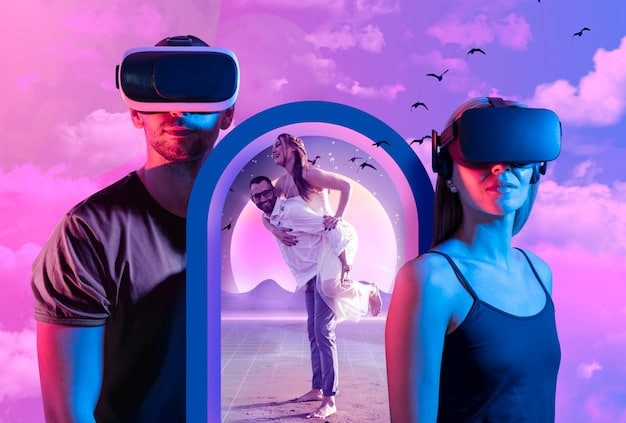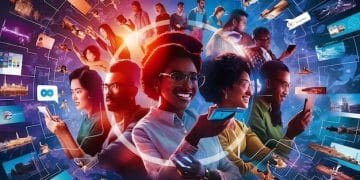The Rise of Influencer Culture: A 2025 Examination

The rise of influencer culture by 2025 signifies a profound shift in marketing, entertainment, and social dynamics, propelled by digital connectivity and evolving consumer trust, reshaping how brands engage audiences and how individuals perceive authenticity and aspiration in the digital age.
In 2025, it’s clear that The Rise of Influencer Culture: A 2025 Examination reveals far more than just a fleeting trend. This phenomenon has matured into a cornerstone of contemporary pop culture, significantly altering traditional media landscapes and consumer behavior.
The Evolution of Digital Influence: From Bloggers to Mega-Influencers
The journey from early internet personalities to today’s mega-influencers is a testament to the rapid evolution of digital platforms. What began with niche blogs and rudimentary video logs has escalated into a sophisticated ecosystem.
Initially, influencers were often accidental, individuals sharing passions who unwittingly amassed followers. Their authenticity was their primary currency, building trust through genuine connection.
Early Adopters and Niche Communities
Early influencers carved out spaces in nascent online communities, focusing on highly specific interests. This created dedicated, engaged audiences, a stark contrast to the broad appeal sought by traditional media.
- Authenticity as a core value.
- Deep engagement within narrow niches.
- Organic growth driven by shared interests.
The transition from these humble beginnings to the polished, often business-savvy content creators of 2025 highlights a professionalization of the industry. This shift moved influence from a hobby to a viable, lucrative career path.
The Professionalization of Content Creation
By 2025, content creation has become a highly structured profession. Influencers often work with management agencies, legal teams, and even public relations specialists, reflecting the immense financial stakes involved.
This professionalism is visible in the production quality of content, the strategic planning behind campaigns, and the meticulous attention paid to audience analytics. It’s no longer just about sharing; it’s about strategizing for maximum impact.
From micro-influencers specializing in hyper-niche topics to macro-influencers commanding millions of followers, the spectrum of influence has broadened, allowing brands to target audiences with unprecedented precision.
Economic Impact and Brand Partnerships: A New Advertising Paradigm
The economic footprint of influencer culture by 2025 is impossible to ignore. It has fundamentally reshaped how brands allocate advertising budgets and engage with consumers.
Traditional advertising channels, while still relevant, often lack the direct, personalized touch that influencers provide. This personal connection has proven to be a powerful driver of consumer decisions.
Shifting Advertising Budgets
Companies are increasingly reallocating significant portions of their marketing budgets towards influencer collaborations. This reflects a clear recognition of the high return on investment that authentic influencer campaigns can deliver.
- Higher engagement rates compared to traditional ads.
- Improved brand perception through trusted voices.
- Direct access to segmented, engaged audiences.
This shift extends beyond just celebrity endorsements, embracing a diverse range of creators whose influence is rooted in genuine community building rather than mass-market appeal.
Measuring ROI and Campaign Effectiveness
In 2025, the tools and metrics for measuring the ROI of influencer campaigns have become highly sophisticated. Brands now analyze everything from reach and engagement to conversion rates and brand sentiment.
This data-driven approach ensures that partnerships are not just about visibility, but about tangible business outcomes. The ability to track consumer behavior from initial exposure to final purchase is a game-changer for marketers.

The transparency around sponsored content has also evolved, with stricter regulations and increased consumer awareness requiring clear disclosures. This fosters greater trust between influencers, brands, and their audience.
The Psychological and Sociological Dimensions of Influence
Beyond economics, influencer culture deeply impacts psychological and sociological facets of modern life. It shapes aspirations, social norms, and even self-perception.
The constant stream of curated content presents a powerful, often idealized, version of reality, influencing everything from lifestyle choices to political opinions.
Impact on Self-Perception and Aspirations
The pervasive presence of highly curated online personas can lead to comparisons and unrealistic expectations. This often manifests in pressures related to perfection, material possessions, and lifestyle choices.
However, many influencers also strive to promote authenticity, vulnerability, and positive self-image, offering counter-narratives that challenge these idealizations. The narrative is complex and multi-faceted.
Consumers are becoming more discerning, recognizing the curated nature of content and often seeking out creators who champion honesty and relatable experiences over pure aspiration.
Community Building and Social Movements
Influencers are not just product recommenders; they are community builders. They foster spaces where like-minded individuals can connect, discuss, and support one another.
- Facilitating niche communities and shared interests.
- Mobilizing support for social and political causes.
- Providing platforms for underrepresented voices.
This communal aspect empowers social movements, allowing information and advocacy to spread rapidly and reach diverse audiences. Influencers can amplify messages, drive conversations, and even spur real-world action on critical issues.
Their ability to bridge the gap between online engagement and offline impact makes them potent forces in shaping the public discourse and driving collective action.
Challenges and Criticisms: Navigating a Shifting Landscape
Despite its pervasive reach, influencer culture is not without its challenges and criticisms. As it matures, concerns about authenticity, ethical practices, and content quality become more prominent.
The pursuit of virality and commercial gain can sometimes overshadow genuine connection and responsible content creation, leading to skepticism among audiences.
Authenticity and Transparency Concerns
One of the biggest criticisms revolves around authenticity. As brand partnerships increase, questions arise about whether recommendations are truly genuine or purely financially motivated.
The rise of paid endorsements and increasingly subtle forms of advertising blurs the lines, requiring clearer disclosure mechanisms and a commitment to transparency from creators and platforms.
Consumers are now highly attuned to these nuances, often prioritizing influencers who maintain a clear, honest relationship with their audience. Maintaining trust is paramount for sustained influence.
Regulatory Landscape and Ethical Guidelines
Governments and industry bodies are increasingly developing regulations and ethical guidelines to govern influencer marketing. These aim to protect consumers and ensure fair practices within the ecosystem.
- Mandatory disclosure of sponsored content.
- Guidelines on misleading claims and advertising.
- Protection of consumer data and privacy.
Compliance with these regulations is crucial for influencers and brands alike, ensuring that the industry operates on a foundation of integrity and responsibility. The landscape is continually evolving to address new challenges.
The challenge for influencers is to balance commercial imperatives with maintaining the trust that forms the bedrock of their appeal. Ethical practices are key to long-term success and credibility.
Technological Advancements and the Future of Influence
By 2025, technological advancements are continually reshaping the forms and functions of influencer culture. Artificial intelligence, virtual reality, and augmented reality are opening new frontiers.
These innovations promise to create even more immersive and personalized experiences, further blurring the lines between the digital and physical worlds.
AI-Driven Personalization and Virtual Influencers
AI is playing a significant role in content personalization, allowing influencers to tailor content more precisely to individual audience preferences. This enhances engagement and relevance.
The emergence of virtual influencers, AI-generated personalities, also presents a fascinating new dimension. These digital entities can embody perfect brand ambassadors, raising questions about authenticity and human connection.
While still in their early stages, virtual influencers offer endless possibilities for brands seeking absolute control over messaging and appearance, though they may lack the human touch that many audiences crave.
Metaverse and Immersive Experiences
The development of the metaverse opens up new, immersive platforms for influencers to connect with their audiences. Virtual spaces offer opportunities for interactive experiences, concerts, and brand activations.
Influencers are exploring how to create compelling content within these 3D environments, leveraging VR and AR technologies to deliver unique and memorable interactions.

These immersive experiences could redefine what it means to “follow” an influencer, moving beyond passive consumption to active participation in shared virtual worlds. The potential for engagement is immense.
From virtual product try-ons to metaverse-hosted events, the integration of new technologies will continue to push the boundaries of what influencer marketing can achieve.
The Cultural Impact and Mainstream Integration
By 2025, influencer culture is no longer a fringe phenomenon; it is deeply woven into the fabric of mainstream pop culture. Its influence extends across all demographics and industries.
From fashion and beauty to politics and education, influencers are shaping narratives, driving trends, and becoming household names in their own right.
Influencers as Mainstream Celebrities
Many influencers have transcended their digital origins to become mainstream celebrities, appearing in traditional media, launching their own businesses, and even venturing into film and music.
Their rise signals a democratization of celebrity, where fame can be achieved through relatability and direct connection rather than traditional gatekeepers. This has shifted the definition of stardom.
This integration blurs the lines between traditional entertainment and digital content, creating a new breed of public figures whose appeal spans multiple platforms and formats.
Shaping Trends and Societal Norms
Influencers are powerful trendsetters, dictating what is fashionable, what is newsworthy, and even what constitutes social acceptability. Their recommendations carry significant weight with their followers.
- Setting fashion and beauty trends.
- Influencing consumer purchasing habits.
- Shaping discourse on social and political issues.
This influence extends to societal norms, as influencers often reflect and amplify cultural shifts. They can normalize new behaviors, introduce innovative ideas, and challenge existing paradigms.
Their collective impact on popular culture is undeniable, making them key figures in chronicling and shaping the contemporary human experience in 2025 and beyond.
| Key Aspect | Brief Description |
|---|---|
| 📈 Market Growth | The influencer market continues significant expansion, fueled by ad spend shifts. |
| 🤝 Brand Integration | Influencers are critical for authentic brand engagement and consumer trust. |
| 🤖 Tech Integration | AI, VR, and metaverse platforms are shaping future influence. |
| ⚖️ Regulations & Ethics | Increasing focus on transparency and ethical content creation. |
Frequently Asked Questions
▼
In 2025, an influencer is broadly defined as an individual who has cultivated a significant following on digital platforms, capable of impacting their audience’s purchasing decisions, opinions, or behaviors. Their influence is built on perceived authenticity, expertise, or relatability within a specific niche, ranging from micro-influencers to mega-celebrities.
▼
By 2025, AI has revolutionized influencer marketing through enhanced personalization, audience analytics, and the emergence of virtual influencers. AI-driven tools help creators understand their audience better and optimize content for maximum engagement, while virtual influencers offer brands a new, controllable avenue for digital marketing, blurring the lines of traditional influence.
▼
Key ethical concerns in 2025 include the transparency of sponsored content, potential for misleading information, and the psychological impact of curated, often idealized, online personas. Regulations are increasing to ensure clear disclosures and prevent deceptive practices, while the industry grapples with promoting authenticity and responsible content creation to maintain consumer trust.
▼
Brands in 2025 are increasingly leveraging micro-influencers for their higher engagement rates and deep, niche community connections. These creators, with smaller but highly dedicated followings, offer a more authentic and cost-effective way to reach specific demographics compared to larger influencers. This strategy allows for more targeted campaigns with better ROI.
▼
All indicators suggest influencer culture will continue its growth trajectory beyond 2025, evolving with technological advancements and shifting consumption habits. Its adaptability to new platforms like the metaverse and its proven ability to drive consumer engagement ensure its enduring relevance. The focus will likely shift more towards immersive experiences, niche communities, and heightened authenticity.
Conclusion
Examining the rise of influencer culture in 2025 reveals a phenomenon that continues to evolve at a relentless pace, shaping not just how we consume products but also how we interact with information and perceive identity. From its organic beginnings to its current, highly professionalized state, digital influence has firmly cemented its place in pop culture and the global economy. While challenges around authenticity and regulation persist, ongoing technological advancements and a growing emphasis on genuine connection indicate a future where influencers remain central to our digital and social lives, continuously redefining the boundaries of communication and community in the modern age.





